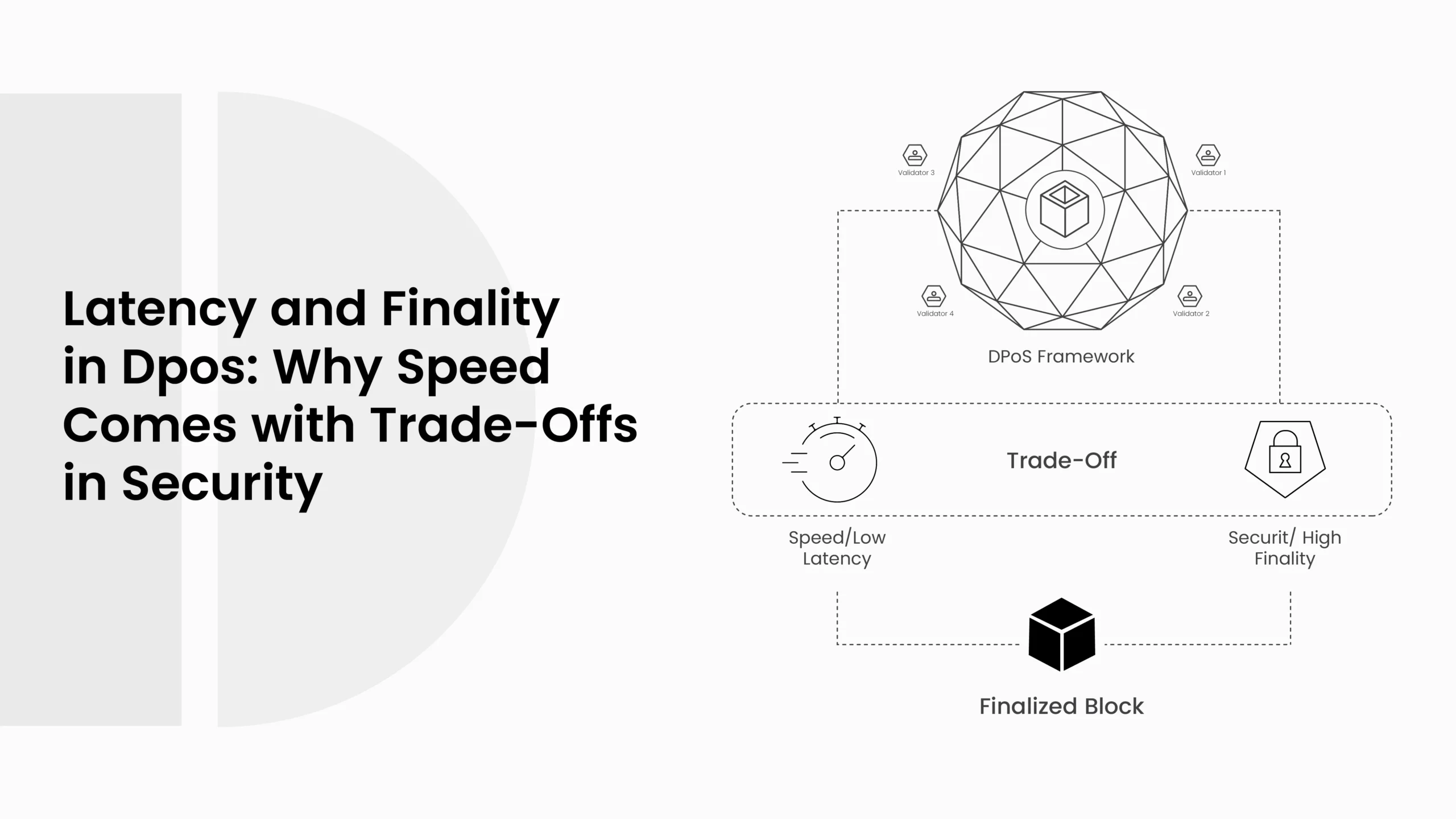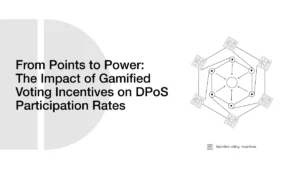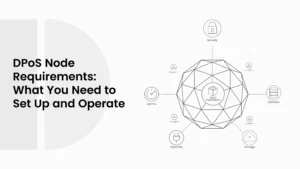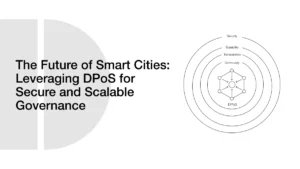Latency and Finality in DPoS: Why Speed Comes with Trade-Offs in Security

Blockchain is built on trust without middlemen. Every system that uses blockchain must decide how fast it wants to confirm transactions and how secure it wants those confirmations to be. Two very important ideas here are latency and finality.
- What Is Latency in Blockchain?
- Latency Comparison In Popular Consensus Systems
- What Is Finality in Blockchain?
- Types Of Finality In Different Consensus Models
- How DPoS Achieves Low Latency and Fast Finality
- The Role of Delegates in Speed
- Block Intervals and Quick Confirmations
- Deterministic Finality in DPoS
- DPoS vs PoW and PoS Speed
- Block Times And Confirmation Speeds In Major Blockchains
- The Security Trade-Offs of Low Latency in DPoS
- Fewer Validators Means Centralization Risk
- Collusion Between Delegates
- Faster Blocks, Less Time for Checking
- Past Issues in DPoS Chains
- Security Trade-Offs In Dpos Compared To PoW And PoS
- Latency vs Security – The Balancing Act
- Why Too Much Speed Can Hurt Security
- Why Some Latency Is Actually Useful
- The Blockchain Trilemma Connection
- Finding the Right Balance
- Balancing Latency And Security Across Consensus Types
- Lessons from On-Chain and Off-Chain Trade-Offs
- On-Chain Storage Is Secure but Slow
- Off-Chain Storage Is Fast but Risky
- Hybrid Models Balance Both Worlds
- Parallels With DPoS Trade-Offs
- Comparing Storage Trade-Offs With Consensus Trade-Offs
- Real-World Applications of DPoS Latency and Finality
- Fast Payments and Microtransactions
- Decentralized Finance (DeFi) and Trading
- Gaming and Virtual Worlds
- Exchange Transfers and Payments Networks
- Dpos Applications And Why Speed Matters
- Emerging Solutions to Improve Both Speed and Security
- Layer-2 Scaling on DPoS Chains
- Hybrid Consensus Models
- Cryptography to Add More Safety
- Better Governance and Voting Systems
- Emerging Solutions For Speed And Security In Dpos
- Conclusion
- Frequently Asked Questions About Latency and Finality in DPoS
- What is latency in blockchain?
- What is finality in blockchain?
- Why does DPoS have faster transactions?
- Does faster blockchain always mean less secure?
- Can DPoS be made safer without losing speed?
- Glossary of Key Terms
Latency means how long the network takes to process and confirm a transaction. Finality means how sure people are that a transaction cannot be changed or reversed. In Proof of Work (PoW) systems like Bitcoin, transactions are slow but very hard to roll back. In Delegated Proof of Stake (DPoS), the network is much faster, but sometimes this speed comes with trade-offs in security.
This balance between speed and safety is not new. Even in blockchain data storage, systems face similar trade-offs. On-chain storage is safe but heavy and slow, while off-chain storage is light but can create risks (Eren, Karaduman, & Gençoğlu, 2025). The same logic applies when looking at how DPoS handles latency and finality.
This blog will explore what latency and finality mean, how DPoS achieves faster speed, and why that speed may also bring certain security risks.
ALSO READ: How DPoS Chains Handle Network Upgrades Compared to PoS and PoW Chains
What Is Latency in Blockchain?
Latency in blockchain means the time it takes for a transaction to be added to the chain and seen as valid. Imagine sending money through Bitcoin. You may need to wait several minutes for the network to pick up your transaction, process it, and add it to a block. That waiting time is the latency.
DPoS networks reduce this waiting time by having a small set of trusted nodes, also called delegates or validators. These nodes are voted in by token holders. Since fewer people are making decisions, blocks can be added very fast. This makes DPoS chains good for applications that need speed, like gaming or real-time payments.
But lower latency does not always mean safer. Faster block times can open the door to issues like centralization and possible rollbacks if something goes wrong. Studies on blockchain performance note that reducing computational steps can boost speed but may also limit overall resilience of the system (Eren et al., 2025).
Latency Comparison In Popular Consensus Systems
| Consensus Type | Average Block Time | Example Chains | Typical Latency |
| Proof of Work (PoW) | 10 minutes | Bitcoin | Very high |
| Proof of Stake (PoS) | 12–15 seconds | Ethereum, Cardano | Medium |
| Delegated Proof of Stake (DPoS) | 1–3 seconds | EOS, TRON | Very low |
What Is Finality in Blockchain?
Finality in blockchain is the idea that once a transaction is confirmed, it can no longer be reversed or changed. This is very important for trust. If people fear that a payment could be rolled back, they will not use the system for serious financial activity.
There are different types of finality across blockchain systems. In Proof of Work, finality is probabilistic. This means that after six blocks in Bitcoin, your transaction is almost certainly safe, but there is still a very small chance it could be reversed. In Proof of Stake and DPoS systems, finality can be deterministic. This means once the majority of validators confirm the block, it is final with no rollback possible.
DPoS is strong in this sense because it gives near instant finality. But there is a cost. Since only a small group of validators confirms transactions, if they collude or are attacked, the system may face risks. Research shows that systems with lower confirmation thresholds have faster finality but depend more heavily on trust in validators.
Types Of Finality In Different Consensus Models
| Consensus Type | Finality Type | Finality Time | Risk of Rollback |
| Proof of Work (PoW) | Probabilistic | 60 minutes (Bitcoin) | Low but possible |
| Proof of Stake (PoS) | Mixed | Seconds to minutes | Medium |
| Delegated Proof of Stake (DPoS) | Deterministic | Seconds | Very low if validators are honest |
This makes DPoS very appealing for businesses that want instant trust in transactions. The same speed can create different kinds of risks that slower blockchains do not face.
How DPoS Achieves Low Latency and Fast Finality
The Role of Delegates in Speed
In DPoS, not everyone makes blocks. Instead, people vote for a small group of trusted delegates, also called block producers or validators. These delegates are responsible for confirming transactions and adding new blocks. Since there are fewer people making decisions, the process is much faster. This is different from PoW, where thousands of miners are competing, and from PoS, where hundreds of validators may need to take turns.
By reducing the number of block makers, DPoS cuts down the waiting time. This is why some DPoS chains can make a block every second or two.
Block Intervals and Quick Confirmations
Another reason DPoS is fast is because of short block intervals. A block interval means the time between each new block. In Bitcoin, it is about 10 minutes. In Ethereum, it is 12 to 15 seconds. In EOS, a popular DPoS chain, it is only 0.5 seconds.
Shorter intervals mean faster transaction confirmation. Users see their payments confirmed almost instantly. This makes DPoS very attractive for apps that need real-time responses, like games or exchanges.
Deterministic Finality in DPoS
DPoS does not rely on probabilistic finality like PoW. Instead, once a supermajority of delegates sign a block, it becomes final right away. This is called deterministic finality. It means there is no need to wait for six confirmations or more. Once the block is sealed, it cannot be reversed unless the delegates themselves misbehave.
This gives users confidence in the system. For example, in TRON, transactions are confirmed in a few seconds, and they are considered final as soon as they are included in the block.
DPoS vs PoW and PoS Speed
The difference in speed is clear when comparing DPoS to other systems. While Bitcoin and Ethereum can feel slow during busy times, DPoS networks stay fast. But this is not just because of the technology. It is also because of the choice to have fewer validators. Speed is gained by trusting a smaller group, which creates both advantages and risks.
Block Times And Confirmation Speeds In Major Blockchains
| Blockchain | Consensus | Block Time | Finality Type | Average Confirmation Time |
| Bitcoin | PoW | ~10 minutes | Probabilistic | ~60 minutes for safety |
| Ethereum (PoS) | PoS | ~12 seconds | Mixed | ~2–3 minutes |
| EOS | DPoS | ~0.5 seconds | Deterministic | 1–2 seconds |
| TRON | DPoS | ~3 seconds | Deterministic | 3–6 seconds |
This table shows why people see DPoS as the fastest choice.
The Security Trade-Offs of Low Latency in DPoS
Fewer Validators Means Centralization Risk
In DPoS, only a small number of delegates control the network. This makes it faster, but it also means power is concentrated. If just a few delegates control most of the voting, they can decide how the system runs. This centralization goes against the original idea of blockchain, which was meant to be fully decentralized.
A study on blockchain systems shows that when you reduce the number of participants to gain speed, you also reduce diversity, which can make the system easier to attack.
Collusion Between Delegates
Another problem comes if delegates work together in the wrong way. If a group of them colludes, they can block certain transactions, change rules, or even reverse blocks before they are finalized. In probabilistic systems like Bitcoin, this is harder because thousands of miners are involved. But in DPoS, if just a few delegates misbehave, the damage could be much larger.
Faster Blocks, Less Time for Checking
When blocks are made every second or two, there is less time for the network to check for mistakes or bad behavior. In slower systems, nodes have more time to validate everything carefully. In DPoS, the system must trust delegates to be honest because there is no time for extra checks. This increases efficiency but also raises the risk of errors slipping through.
Past Issues in DPoS Chains
Real-world cases show these risks. On the EOS network, there have been times when transactions were frozen due to governance fights. On TRON, critics have said that a few large stakeholders control most of the voting power, creating questions about fairness. These examples show that while DPoS gives speed, it can also bring political and governance problems.
Security Trade-Offs In Dpos Compared To PoW And PoS
| Consensus | Strength | Weakness | Security Risk |
| Proof of Work (PoW) | Highly decentralized | Very slow | 51% attack, but costly |
| Proof of Stake (PoS) | Balanced decentralization | Medium speed | Risk of “nothing at stake” attacks |
| Delegated Proof of Stake (DPoS) | Very fast finality | Centralized control | Delegate collusion, governance capture |
This table shows that the same thing that makes DPoS fast, fewer validators, is also what makes it less secure.
Latency vs Security – The Balancing Act
Why Too Much Speed Can Hurt Security
Blockchain systems must balance speed and security. If blocks are created too quickly, the system may not have enough time to check if everything is valid. This can allow mistakes or even attacks to slip through. A slower system like Bitcoin avoids this because it takes more time to confirm each block. But the trade-off is that transactions feel very slow.
Why Some Latency Is Actually Useful
Latency is not always a bad thing. In fact, having some delay in confirmation can help protect the network. It gives more time for nodes to check if blocks are valid and if transactions are honest. Think of it like airport security. If people rush through too fast, bad items might go undetected. A little waiting time increases trust in the system.
The Blockchain Trilemma Connection
This debate links directly to the “blockchain trilemma.” The trilemma says blockchains can only optimize two out of three: speed (scalability), security, and decentralization. DPoS chooses speed and some level of decentralization but often sacrifices security. PoW does the opposite: high security and decentralization, but slow speed. PoS sits in the middle, trying to balance all three.
Finding the Right Balance
The balance depends on the use case. A game that needs instant transactions may accept lower security because the value at risk is small. A global bank transfer, on the other hand, needs maximum security, even if it takes longer. DPoS works best for high-volume, low-value activities, while slower blockchains may be better for sensitive transactions.
ALSO READ: DPoS and Rent-Seeking Behavior: How Validators Can Extract Value Without Adding Utility
Balancing Latency And Security Across Consensus Types
| Consensus | Latency (Speed) | Security Strength | Best Use Case |
| Proof of Work (PoW) | Very slow | Very strong | High-value transfers, Bitcoin |
| Proof of Stake (PoS) | Medium | Strong | General-purpose apps, Ethereum |
| Delegated Proof of Stake (DPoS) | Very fast | Weaker than PoW/PoS | Gaming, micro-payments, DeFi apps |
This table makes it clear: no system is perfect. Each design makes a choice about what to prioritize.
Lessons from On-Chain and Off-Chain Trade-Offs
On-Chain Storage Is Secure but Slow
In blockchain data storage, keeping everything on-chain means all data is inside the blockchain itself. This gives maximum security and immutability. Nobody can change the records without the entire network noticing. But the downside is a very high cost and slower performance. Every node must store the full data, which creates heavy latency.
This is similar to PoW systems, where security is strong but transactions take a long time.
Off-Chain Storage Is Fast but Risky
Off-chain storage keeps the bulk of the data outside the blockchain, using systems like IPFS or Filecoin. This reduces costs and makes things run faster. But the trade-off is security. If the off-chain part is attacked or corrupted, the system may lose data integrity. Blockchain can still reference the data through hashes, but the trust is not as strong.
This mirrors how DPoS speeds up transactions by limiting validators. The speed is high, but the trust depends on fewer parties.
Hybrid Models Balance Both Worlds
Many systems now use hybrid storage: important data stays on-chain, while large or less sensitive data is kept off-chain. This balances speed and security. The same idea applies to consensus. Some new blockchains try to mix PoS and DPoS features to gain both safety and efficiency.
Research notes that hybrid approaches are becoming popular in both storage and consensus because they offer a middle path (Eren et al., 2025).
Parallels With DPoS Trade-Offs
The lesson is clear: every system faces a trade-off between speed and safety. On-chain storage and PoW lean toward security but are slow. Off-chain storage and DPoS lean toward speed but take on more risks. Hybrid models are attempts to balance the two sides, but they also add complexity.
Comparing Storage Trade-Offs With Consensus Trade-Offs
| System Type | Speed | Security | Example | Similarity to Consensus |
| On-Chain Storage | Low | Very high | Bitcoin stores all transactions | PoW security-first |
| Off-Chain Storage | High | Lower | IPFS, Filecoin | DPoS speed-first |
| Hybrid Storage | Medium | Balanced | Arweave, Layer-2 systems | PoS/Hybrid consensus |
This table shows how the same trade-off appears in different parts of blockchain: storage and consensus both face the choice between speed and security.
Real-World Applications of DPoS Latency and Finality
Fast Payments and Microtransactions
DPoS is very useful for small, quick payments. For example, if someone is playing a game or tipping on a social media app, they cannot wait 10 minutes for a Bitcoin confirmation. They need speed. DPoS gives block times of just a few seconds, which makes it perfect for microtransactions.
Decentralized Finance (DeFi) and Trading
In DeFi apps, people need to move tokens fast between platforms. If trading is slow, they may lose money because prices change every second. DPoS finality helps here because once a trade is confirmed, it is final and cannot be rolled back. This protects users and makes DeFi apps smoother.
Gaming and Virtual Worlds
Blockchain games and virtual economies need speed more than security in many cases. Players buy and sell items in real time. If they had to wait minutes for confirmation, the game would feel broken. DPoS is used by some blockchain gaming projects because it can process thousands of transactions per second.
Exchange Transfers and Payments Networks
Crypto exchanges often use DPoS-based systems for quick deposits and withdrawals. This makes them attractive to users who do not want to wait long for funds to clear. At the same time, this raises risks if exchanges rely too heavily on systems that may be less secure.
Dpos Applications And Why Speed Matters
| Use Case | Why Speed Is Needed | Why Finality Matters |
| Microtransactions | Users want instant payment in apps or games | Prevents disputes over payments |
| DeFi Trading | Prices move quickly | Traders need finality to avoid rollbacks |
| Gaming | Real-time actions in virtual economies | Ensures items and tokens are locked in |
| Exchange Transfers | Fast deposits and withdrawals | Reduces fraud and double-spend risks |
This table shows that DPoS is strong in places where speed is the top priority, but the risk of centralization still exists in the background.
Emerging Solutions to Improve Both Speed and Security
Layer-2 Scaling on DPoS Chains
One way to improve both speed and safety is by adding Layer-2 solutions. These are systems built on top of the blockchain that process many transactions off-chain, then settle the results on-chain. This lowers congestion while still keeping the blockchain secure. Projects in DeFi are testing these methods to make DPoS more reliable for bigger networks.
Hybrid Consensus Models
Some blockchains try to combine different consensus systems. For example, they may use DPoS for fast block creation but PoS or BFT (Byzantine Fault Tolerance) for final settlement. This creates a mix where users get both speed and stronger security. Hybrid designs are becoming popular because no single method can solve the trilemma fully.
Cryptography to Add More Safety
New cryptographic methods like Zero-Knowledge Proofs (ZKPs) and Fully Homomorphic Encryption (FHE) are being studied. These tools let blockchains confirm data without revealing everything. They also help prevent fraud in fast systems. Research shows that cryptography can make decentralized systems safer without slowing them down too much.
Better Governance and Voting Systems
Another area of innovation is governance. In many DPoS chains, the voting power is held by a few whales. To fix this, new models are being tested where voting is spread more fairly. If governance becomes more secure, the network can trust fast finality without worrying as much about collusion.
ALSO READ: Is DPoS Ready for AI-Generated Smart Contracts and Autonomous DAOs?
Emerging Solutions For Speed And Security In Dpos
| Solution Type | How It Helps Speed | How It Improves Security |
| Layer-2 Scaling | Moves many transactions off-chain | Reduces congestion and fraud risk |
| Hybrid Consensus | Uses DPoS for speed, PoS/BFT for safety | Balances performance with trust |
| Advanced Cryptography (ZKPs, FHE) | Keeps confirmations quick | Adds strong privacy and fraud prevention |
| Improved Governance Models | Keeps block times low | Prevents centralization of power |
This table shows that the future of DPoS may not be about choosing speed or security, but about designing systems that can have both in smarter ways.
Conclusion
Latency and finality are two of the most important ideas in blockchain. They decide how fast a network runs and how safe transactions are once confirmed. Delegated Proof of Stake (DPoS) shows that speed is possible. With blocks confirmed in seconds, it looks much faster than Proof of Work or even many Proof of Stake systems.
But this speed does not come for free. Lower latency and instant finality also mean more trust in a small group of delegates. That can create risks like centralization, collusion, or weaker checks against mistakes. Research on blockchain storage shows the same truth: whenever speed is increased, some security is lost, unless a hybrid model balances both sides.
The future of DPoS may not be about choosing only speed or only safety. New solutions like Layer-2 scaling, hybrid consensus, cryptography, and fairer governance models aim to give blockchains both qualities. For now, DPoS is best for systems that need instant transactions, like gaming, DeFi, and micro-payments, but it may need upgrades for very high-value use cases.
Frequently Asked Questions About Latency and Finality in DPoS
What is latency in blockchain?
Latency is the time it takes for a transaction to be added to the blockchain. DPoS networks have very low latency, often just 1–3 seconds.
What is finality in blockchain?
Finality means a transaction cannot be reversed. In DPoS, finality is deterministic, meaning once confirmed, it is final right away.
Why does DPoS have faster transactions?
Because it uses a small group of trusted delegates instead of thousands of miners. Fewer people make decisions, so blocks are added quickly.
Does faster blockchain always mean less secure?
Not always, but often. Lower latency usually means less time for checks, so the system must trust validators more.
Can DPoS be made safer without losing speed?
Yes. With hybrid consensus, cryptography, and better governance, DPoS can improve both speed and safety.
Glossary of Key Terms
Latency – The delay or waiting time for a transaction to be confirmed in a blockchain.
Finality – The point when a blockchain transaction is locked in and cannot be changed.
Delegate – A validator or block producer chosen by token holders in DPoS to confirm transactions.
Consensus – The method blockchains use to agree on the next block. Examples include PoW, PoS, and DPoS.
Centralization – When control is held by a small group instead of being spread out across many users.
Byzantine Fault Tolerance (BFT) – A property of systems that allows them to keep working even if some members act dishonestly.



